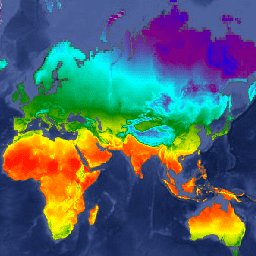
- Доступность набора данных
- 1960-01-01T00:00:00Z–1991-01-01T00:00:00Z
- Поставщик наборов данных
- Калифорнийский университет в Беркли
- Теги
- , Биоклим
Описание
WorldClim V1 Bioclim предоставляет биоклиматические переменные, которые выводятся на основе месячной температуры и количества осадков для получения более биологически значимых значений.
Биоклиматические переменные отражают годовые тенденции (например, среднегодовая температура, годовое количество осадков), сезонность (например, годовой диапазон температур и осадков) и экстремальные или ограничивающие факторы окружающей среды (например, температура самого холодного и самого теплого месяца и осадки влажных и сухих кварталов).
Схема полос соответствует схеме ANUCLIM, за исключением того, что для сезонности температуры использовалось стандартное отклонение, поскольку коэффициент вариации не имеет смысла при температурах от -1 до 1.
WorldClim версии 1 был разработан Робертом Дж. Хиджмансом, Сьюзен Кэмерон и Хуаном Паррой из Музея зоологии позвоночных Калифорнийского университета в Беркли в сотрудничестве с Питером Джонсом и Эндрю Джарвисом (CIAT), а также с Карен Ричардсон (Rainforest CRC).
Группы
Размер пикселя
927,67 метра
Группы
| Имя | Единицы | Мин. | Макс | Шкала | Размер пикселя | Описание |
|---|---|---|---|---|---|---|
bio01 | °С | -29* | 32* | 0.1 | метров | Среднегодовая температура |
bio02 | °С | 0,9* | 21.4* | 0.1 | метров | Средний суточный диапазон (средний месячный (макс. температура - мин. температура)) |
bio03 | % | 7* | 96* | метров | Изотермичность (био02/био07 * 100) | |
bio04 | °С | 0,62* | 227.21* | 0,01 | метров | Сезонность температуры (стандартное отклонение * 100) |
bio05 | °С | -9.6* | 49* | 0.1 | метров | Максимальная температура самого теплого месяца |
bio06 | °С | -57,3* | 25.8* | 0.1 | метров | Минимальная температура самого холодного месяца |
bio07 | °С | 5.3* | 72,5* | 0.1 | метров | Годовой диапазон температур (био05-био06) |
bio08 | °С | -28,5* | 37,8* | 0.1 | метров | Средняя температура самого влажного квартала |
bio09 | °С | -52.1* | 36,6* | 0.1 | метров | Средняя температура самого сухого квартала |
bio10 | °С | -14.3* | 38.3* | 0.1 | метров | Средняя температура самого теплого квартала |
bio11 | °С | -52.1* | 28.9* | 0.1 | метров | Средняя температура самого холодного квартала |
bio12 | мм | 0* | 11401* | метров | Годовое количество осадков | |
bio13 | мм | 0* | 2949* | метров | Осадки самого дождливого месяца | |
bio14 | мм | 0* | 752* | метров | Осадки самого сухого месяца | |
bio15 | Коэффициент вариации | 0* | 265* | метров | Сезонность осадков | |
bio16 | мм | 0* | 8019* | метров | Осадки самого влажного квартала | |
bio17 | мм | 0* | 2495* | метров | Осадки самого сухого квартала | |
bio18 | мм | 0* | 6090* | метров | Осадки самого теплого квартала | |
bio19 | мм | 0* | 5162* | метров | Осадки самого холодного квартала |
Условия эксплуатации
Условия эксплуатации
Цитаты
Хиджманс, Р. Дж., С. Э. Кэмерон, Дж. Л. Парра, П. Г. Джонс и А. Джарвис, 2005. Интерполированные климатические поверхности с очень высоким разрешением для территорий суши мира. Международный журнал климатологии 25: 1965-1978. doi:10.1002/joc.1276 .
Исследуйте с Earth Engine
Редактор кода (JavaScript)
var dataset = ee.Image('WORLDCLIM/V1/BIO'); var annualMeanTemperature = dataset.select('bio01').multiply(0.1); var visParams = { min: -23, max: 30, palette: ['blue', 'purple', 'cyan', 'green', 'yellow', 'red'], }; Map.setCenter(71.7, 52.4, 3); Map.addLayer(annualMeanTemperature, visParams, 'Annual Mean Temperature');
